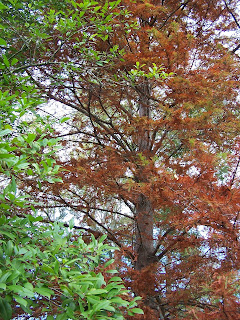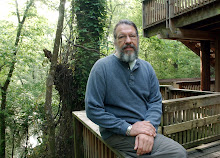Swamp Red Maple (Acer drummondii)
Yeah yeah, I know. Down here along the Gulf Rim there's not much fall foliage color to brag about. But what we do have is a winter foliage color show – not in vast expanses, mind you, but definitely in small clumps here and there. It's not exactly gonna rip the eyes right out of your head; rather, it's a matter of opening one's eyes and actually looking for it.
Baldcypress intermingling with a hybrid Holly
(Ilex opaca x cassine) in our backyard;
excellent contrast in both color and texture
Generally, our winter foliage color season begins in November, when baldcypress (Taxodium distichum) reveals the first hints of rust color in its needles. Other early colorizers include black cherry (Prunus serotina) and cedar elm (Ulmus crassifolia). With each passing day, the cypress colors up a little more, until finally around Thanksgiving it drops everything, thickly covering the ground below with a rich, rusty-red carpet.
Cedar Elm (left) and American Hornbeam (right)
provide a nice combination behind our barn
Swamp Cyrilla (Cyrilla racemiflora) is a personal favorite, turning
red/orange/yellow gradually, and over a long period of time
Witch Hazel provides yellow fall color AND fragrant blooms;
all in November!
Black Cherry going orange-yellow
on the northern edge of our backyard
Meanwhile, additional pockets of color can be found in individual specimens of swamp red maple (Acer drummondii), American hornbeam (Carpinus caroliniana), sweetgum (Liquidambar styriciflua) and sassafras – and of course Chinese tallow (Sapium sebiferum), but decent folks don't like to talk about that one . . .
Wetland oaks including Nuttall (Quercus texana) and overcup (Q. lyrata) don't begin turning until December; but by Christmas they are both wonders to behold.
Let it be known as well that there are a few outstanding winter-foliage natural areas in northern Louisiana which are easily accessible. The best by far is Sicily Island Hills Wildlife Management Area (see http://sicilyislandhills.com/ and http://www.stateparks.com/sicily_island_hills.html ) in extreme northeastern Catahoula parish; and the best time for winter color is Thanksgiving week. Also visit-worthy are Walter B. Jacobs Memorial Nature Park and Eddie Jones Park (http://www.caddoparks.com/findpark.cfm ), both in Caddo parish around Shreveport. Both of those park feature, among numerous other color plants, stands of southern sugar maple (Acer barbatum), one of the most stunningly colorful of all our winter plants. The Macon Ridge, an ancient Mississippi River escarpment up in Morehouse parish above Monroe also holds nice stands of southern sugar maple. Kalorama Nature Preserve http://www.facebook.com/pages/Kalorama-Nature-Preserve/111378675635675 is a fine destination on Macon Ridge. Check it out. And check out Kalorama curator Beth Erwin's fine blog (http://arborlady.blogspot.com/) 'The View From the Hill' while you're at it.
Fall/winter foliage color arises from red, orange, and yellow-pigmented metabolic wastes (carotenoids, anthocyanins, etc.) which are actually contained in the leaves long before we see them. Toward the end of a leaf's life, chlorophyll production ceases; and once all the residual chlorophyll drains out, its metabolic wastes are finally unmasked.








No comments:
Post a Comment